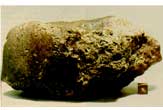Mars Meteorite Not Evidence of Extraterrestrials

What some argue is evidence of ancient life in a meteorite from Mars could have a simple chemical explanation, scientists now suggest.
These findings could also shed light on of the tricky chemistry going on in the atmospheres of both Mars and Earth.
Impacting space rocks on Mars over the years have hurled debris off the planet, some of which has landed on Earth. One such rock — the 3.9 billion-year-old meteorite known as ALH84001 — had globular, micron-sized carbonate particles seemingly arranged in chains that some thought must have been made by ancient Martian life.
However, researchers have now discovered a new way to form carbonates on Earth without interference from biological organisms. They suggest this process likely takes place on Mars as well.
Unusual oxygen type
The carbonates seen in ALH84001 possessed unusually high levels of the isotope oxygen-17. (An oxygen atom has eight protons in its nucleus, and while most of these also have eight neutrons, oxygen-17 has nine.)
Atmospheric chemist Robina Shaheen at the University of California at San Diego discovered anomalously high levels of oxygen-17 in carbonates found on dust grains, aerosols and dirt on Earth as well. This hinted that a chemical process common to both planets might be at work.
Sign up for the Live Science daily newsletter now
Get the world’s most fascinating discoveries delivered straight to your inbox.
Shaheen calculated that ozone in the atmosphere could interact with oxygen-bearing mineral aerosols from dust and other sources to form hydrogen peroxide and carbonates possessing this same oxygen-isotope anomaly. "What she found is that the tiny little layer on the outside of the grain is where this chemistry all happens," said researcher Mark Thiemens, a planetary scientist at the University of California at San Diego.
Shaheen's analysis of the carbonates in ALH84001 suggested they could have been formed on aerosols in the ancient Martian atmosphere. NASA's Phoenix lander recently detected carbonates linked with particulates in the dusty atmosphere of Mars. "We think it might be this same mechanism that is operating," she said.
Although the researchers think the carbonate particles seen in ALH84001 are probably not biological in origin, "that doesn't mean that life is impossible on Mars," Thiemens cautioned.
This chemical process might not only shed light on the past and present of Mars, but it could also do the same for our planet as well. For instance, current models of atmospheric processes on Earth assume that the mixing of large volumes of gases drives the chemistry of the Earth's atmosphere. This new work might force a rethinking of this idea, scientists said, especially as the Earth's atmosphere becomes warmer and dustier due to climate change, providing more opportunities for this kind of chemistry to take place on aerosols.
"The chemical transformations aerosols can undergo could make them seeds for cloud formation when before we thought they could not, which has huge implications regarding the water cycle and probabilities of rain," Shaheen told SPACE.com.
Window into Earth's past
Scientists could also peer into Earth's atmosphere as it was in the past, particularly its oxygen levels, by examining carbonates found in rocks that are hundreds of millions of years old, researchers said. This could provide a window to early Earth far beyond the 60,000 years or so back that scientists can now study via ice core samples.
"We've found a new way to measure the earth's atmosphere for time periods when we previously could not do it," Thiemens said. "What happened to ozone and oxygen levels 65 million years ago during the Cretaceous-Tertiary period when the dinosaurs and many other forms of life were killed in a mass extinction? Who died first? Did the food chain disappear before the dinosaurs? What happened 251 million years ago during the Permian-Triassic period, the most severe extinction of life on Earth, when 85 percent of life disappeared and no one knows why? There's no record of what happened in the atmosphere. But if you can find a record of what happened to oxygen levels, you can answer questions like that."
Ancient carbonate might even shed light on the origins of complex life, Thiemens said.
"If you want to understand the origin and evolution of complex life, oxygen is your number one culprit," Thiemens told SPACE.com. "The most interesting time carbonates might be able to look at would be about 500 million years ago, back when the Earth was frozen solid. Prior to that time, there's no life except algae and bacteria. After that, all this life that depends on oxygen appears, and how that happened is something that's still uncertain."
Shaheen, Thiemens and their colleagues detailed their findings online Nov. 8 in the journal Proceedings of the National Academy of Sciences.
This article was provided by SPACE.com, a sister site of Live Science.










